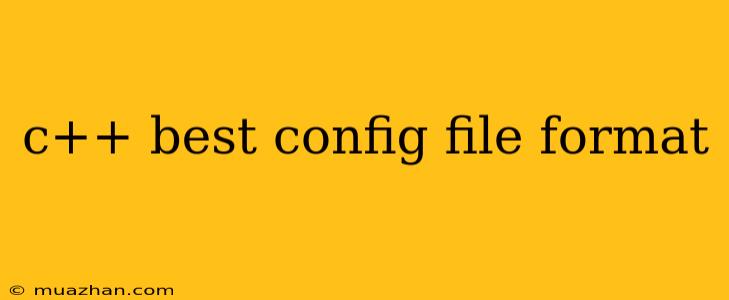C++ Best Configuration File Format
Choosing the right configuration file format for your C++ project is crucial for maintainability, flexibility, and ease of use. Here's a breakdown of popular options and their strengths:
1. JSON (JavaScript Object Notation)
Strengths:
- Human-readable: JSON's structure is simple and easy to understand, even for non-programmers.
- Widely adopted: Used extensively in web development and many other fields, making it a familiar format for many developers.
- Easy to parse: C++ libraries like nlohmann/json provide efficient and reliable parsing.
- Versatile: Can represent complex data structures like arrays, objects, and nested structures.
Example:
{
"name": "My Application",
"version": "1.0.0",
"settings": {
"database": {
"host": "localhost",
"port": 3306,
"user": "myuser",
"password": "mypassword"
},
"logging": {
"level": "DEBUG",
"file": "application.log"
}
}
}
2. YAML (YAML Ain't Markup Language)
Strengths:
- Highly readable: YAML offers a more readable and concise syntax with indentation-based structure.
- Flexible data types: Supports various data types like strings, numbers, booleans, lists, and maps.
- Comments allowed: Enables easy documentation within the configuration file.
- Good for complex configurations: Its hierarchical structure makes it ideal for representing nested configurations.
Example:
name: My Application
version: 1.0.0
settings:
database:
host: localhost
port: 3306
user: myuser
password: mypassword
logging:
level: DEBUG
file: application.log
3. INI (Initialization File)
Strengths:
- Simple and lightweight: INI files are easy to create and understand, with a basic key-value pair structure.
- Widely supported: Numerous libraries exist for parsing INI files in C++.
- Suitable for smaller configurations: Works well for simple configurations with a limited number of settings.
Example:
[General]
Name=My Application
Version=1.0.0
[Database]
Host=localhost
Port=3306
User=myuser
Password=mypassword
[Logging]
Level=DEBUG
File=application.log
4. XML (Extensible Markup Language)
Strengths:
- Standardized format: Widely used and well-defined with a defined schema.
- Supports complex data structures: XML provides a rich structure for representing complex data with elements, attributes, and namespaces.
- Validation capabilities: Allows schema-based validation for ensuring data integrity.
Example:
My Application
1.0.0
localhost
3306
myuser
mypassword
DEBUG
application.log
Choosing the Best Format
The ideal configuration file format depends on your specific project needs:
- Simplicity and readability: INI and YAML are excellent choices for smaller and easier-to-understand configurations.
- Complexity and data structure: JSON and XML provide more structure and support for complex data representations.
- Existing libraries and ecosystem: Consider the availability of parsing libraries and community support for your chosen format.
Ultimately, the best configuration file format for your C++ project is the one that aligns with your requirements and improves code maintainability, flexibility, and ease of use.
